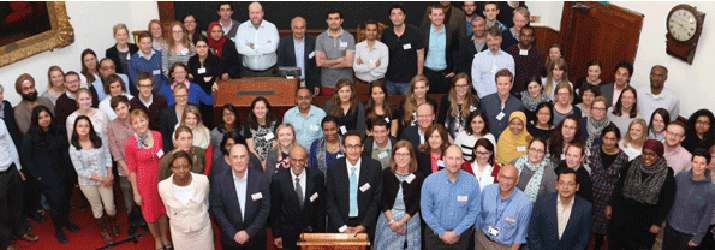

When a patient presents with a typical infectious illness, he or she will often provide a basic history, identifying key risk factors and their pre-morbid health state, cooperate with an exam while displaying valuable clinical signs, helpfully cough up or urinate a sample for culture, and respond fairly quickly to targeted therapy.
Infections of the nervous system present barriers to all of the above. Confusion obtunds the historian and hampers the exam, yielding limited and non-specific findings. We cannot easily sample the brain parenchyma. The Cerebrospinal fluid (CSF) provides an alternative, although direct observation of the pathogen may be limited; we may only be able to track its footprints via serology and Polymerase Chain Reaction (PCR). Lumbar punctures (LP) may be feared by patients. Neuro-imaging findings are often non-specific, and timely Magnetic Resonance Imaging (MRI) can be difficult to obtain. Finally, the optimal delivery of treatment across the blood-brain barrier requires expert knowledge, optimal regimes and, for some drugs, doses verging on toxic.
Many doctors would agree that neurology is their Achilles heel, and infectious diseases of the Central Nervous System (CNS) are among the most difficult areas of medicine to diagnose and treat. This course is for them.
Running over two days, with over 100 attendees from as far as Australia, the Liverpool Neuro-Infectious Diseases (ID) course 2015 was organised to provide helpful instructions in managing common neuro-infections as well as many stimulating discussions on current research and rarer, more exotic cases. We learned the essentials of interpreting MRI studies from Dr Maneesh Bhojak, and put our skills into practice in Dr Andy Ustianowski’s session on HIV patients with lesions such as toxoplasmosis, Tuberculosis (TB), CNS Lymphoma and Progressive Multifocal Leukoencephalopathy (PML). Dr Jonathan Folb gave us the microbiology expertise on diagnosing meningitis, as well as common pitfalls; Dr Katherine Ajdukiewicz presented an update on managing these patients, as well as reviewing the evidence for current practices such as adjunctive steroids, and the changing pattern of infection with pneumococcus and different meningococcal sero-groups. These examples illustrate how well-structured a course this was, with sessions scheduled to build on established knowledge.
There were practical guides on recognising neurological diseases in returning travellers, including a detailed session on Tick Borne Encephalitis (TBE) from Dr Ales Chrdle, an infectious disease (ID) specialist working in the Czech Republic where the disease is highly prevalent. Dr Chrdle has vast experience of the disease and his expertise was very enlightening; certainly this condition will be in my mind when seeing patients with recent travel to Bohemia. Interactive case presentations from ID and neurological experts covered rarer diseases such as Chikungunya, Tetanus, Sub-acute Sclerosing Pan Encephalitis and Rabies. These allowed us to engage in the diagnostic process, as well as hear expert advice on best management. Notably the course covered paediatric and adult conditions, providing broad appeal to many trainees.
There were multiple presentations from researchers from international units, and a poster competition featuring topics such as CD8 Encephalitis, complement factor deficiency, Neurosyphilis manifesting as Optic Neuritis, and Anti-NMDA Encephalitis arising in the context of herpes simplex infection.
The Richard T Johnson keynote lecture was delivered by Professor Avindra Nath of the National Institute of Neurological Disorders and Stroke in the USA, who described his hugely successful career as a neuro-infection specialist, including his work into the ‘nodding disease’ epidemic in Uganda, the discovery of genetically coded retroviruses in subtypes of Motor Neuron Disease, key virulence factors in neurological HIV, and perhaps most importantly, the art of performing fundoscopy in an Ebola suit.
The lectures raised recurring questions. How do some patients shrug off a pathogen which unleashes a hugely destructive illness in others? How much neurological damage is directly mediated by the pathogen and how much is induced by the inflammatory response, and might this be useful for treatment? Dr Nick Davies’ presentation on overlapping viral and autoimmune encephalitides demonstrated there may well be elements of both. Finally, with the changing patterns of migration, climate, and evolution of resistance, what is the future of neuro-ID going to look like?
In addition to the high-quality presentations, this was a highly sociable course. The first day closed with a drinks reception followed by dinner in a Thai restaurant. For the more physically active attendees, a five kilometre ‘fun run’ took place at 7am the following morning, offering a guided tour of Liverpool by Professor Tom Solomon at a merciless pace (his twitter handle is @RunningMadProf!).
This course would be useful to anyone daunted by neurological infections, of which there are likely to be many of us. The variety and balance of content was excellent, and speakers were engaging and enthusiastic about their subjects. I would recommend it to those who are considering a career in neurology or ID, and for anybody who is at all curious about this fascinating and expanding subject. The course also offered 10 CPD points towards delegate professional development portfolios. For more information on the Neuro-ID course run by Professor Tom Solomon and colleagues at The Liverpool Brain Infections Group, University of Liverpool please visit www.liv.ac.uk/neuroidcourse

ACNR 2015;15(3):22. Online 30/07/2015